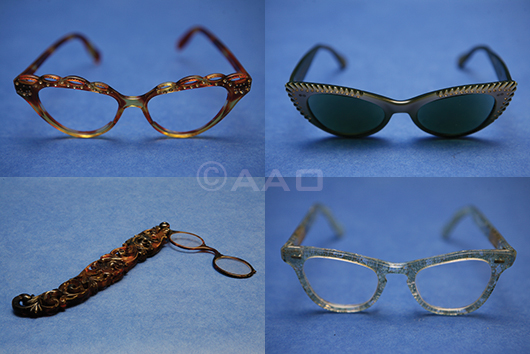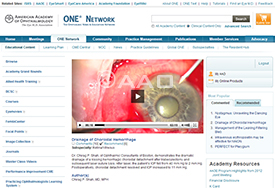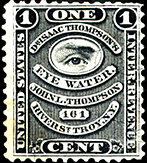What's Happening
The Museum of Vision Exhibits at SFO
In June, the Museum of Vision (MOV) contributed to Classic Plastics, an exhibit on the history of plastics at the San Francisco International Airport’s SFO Museum. The exhibition will run through November and is displayed in the International Terminal. The exhibit is located in the outer concourse prior to security; no boarding pass is needed for access. On display are early celluloid hair combs, Lucite purses, the first Eames chair, Bakelite radios, and jewelry, among other items. One case is devoted solely to the MOV loan, which features 29 pieces, including vintage plastic eyeglasses from the late 1800s through 1979 and a few lorgnettes (spectacles with handles) from the 1920s to the 1960s.
This is not the first collaboration between the MOV and SFO Museum. Past MOV exhibitions at the airport include Spectacular Spectacles in 2004 and the photo show Advertising Eye in 2005. Even earlier, in 1989 the MOV contributed to The Eyes Have It, a collection of eyewear emphasizing the history and aesthetics of eyewear from the 1700s to present day.
“SFO Museum is delighted to have the opportunity to once again display collections from the American Academy of Ophthalmology, particularly because plastic eyeglasses are such an important example of the revolutionary impact that plastic had on so many important everyday items,” said Nicole Mullen, SFO Museum’s curator of exhibitions.
SFO Museum, established in 1980, is the only accredited museum located in an international airport. Exhibitions cover a range of subjects from art to history to science and change frequently to provide an enriching cultural experience for travelers.
To view the Museum of Vision online exhibits, visit www.museumofvision.org. For more about SFO Museum’s exhibits, visit www.flysfo.com/museum.
 |
|
PLASTICS. The Museum of Vision provides vintage eyeglasses to display at the San Francisco International Airport Museum.
|
Take Notice
Ask the Ethicist: Ophthalmologists With Industry Ties
Q: A patient found my name in a database on www.propublica.org, which shows that I have received a $1,000 consultant fee from a pharmaceutical company. My patient asked if the payment affects my prescribing. What is this website? How should I discuss physician-industry relationships with my patients?
A: ProPublica is a nonprofit news organization focusing on independent investigative journalism. Founded by philanthropists in 2008, it has reported on topics from the BP oil spill to housing foreclosures. In 2009, ProPublica started investigating ties between physicians and drug companies, which led to the “Dollars for Docs” series of online articles. They also created a database listing more than $2 billion in payments from 15 pharmaceutical companies to physicians and other health care providers. These data come from companies that are required by state laws or legal settlements to disclose the payment information.
Eventually, all drug and device manufacturers will be required to disclose such payments under the Physician Payment Sunshine Act. The act covers physicians, teaching hospitals, and any entity that receives payments for a covered recipient, such as grants or charity contributions. The act does not cover physicians who are employees of the company making the disclosure, nor does it cover licensed health professionals other than MDs and DOs. The deadline for companies to report payments is March 31, 2014, and the payments will be published on Sept. 30, 2014 (June 30 in the following years).
ProPublica’s belief that patients want to know if their doctor is receiving compensation from a company was confirmed in a 2010 Consumer Reports survey. Of 1,250 respondents, 70 percent said doctors should tell their patients if they are being paid by the company that makes the prescribed drug. In addition, 75 percent said they would be concerned about getting the best treatment if their doctor were accepting drug company payments. To respond to these concerns, ophthalmologists should learn how to explain ethical relationships with industry.
When responding to patients about this issue:
- Be forthcoming. Explain what the payment was for and whether that particular company manufactures any of your patient’s prescriptions.
- Don’t rush to separate industry and medicine. Instead, explain the connection and describe how physicians move therapies from the lab to the clinic by assisting with pharmaceutical trials.
- Discuss the benefits. Even for drugs that are already approved, there are ethical reasons for a physician to speak or consult for a drug company. Practice patterns are difficult to change, and companies utilize physicians to educate one another. Articulate the importance of these relationships to curious patients.
For more information or to submit a question, contact the Ethics Committee staff at ethics@aao.org. To read the Code of Ethics, visit www.aao.org/ethics and select “Code of Ethics.”

ONE SPOTLIGHT: A High-Volume Resource. The ONE Network now has more than 1,000 videos. Watch step-by-step surgical procedures ranging from novel approaches for handling challenging complications to reviews of the basics; listen as experts discuss the latest developments in ophthalmic care; and review footage from recent conferences. The video library covers all subspecialties as well as comprehensive ophthalmology. Recent videos include the following:
- Interviews from 2013 meetings held by the American Society of Cataract and Refractive Surgery, the American Glaucoma Society, and the Association for Research in Vision and Ophthalmology
- More than 100 presentations from the 2012 Subspecialty Day and the 2012 Joint Meeting Spotlight sessions
- Master Class videos on pediatric and strabismus surgery
To learn more, visit www.aao.org/one and click on “Videos and Podcasts” under “Educational Content.” |
Impact the Future of Premium IOLs
Collaborate with Food and Drug Administration (FDA) staff, fellow clinicians, academicians, and industry experts in a workshop jointly sponsored by the FDA and the Academy titled “Developing Novel Endpoints for Premium Intraocular Lenses [IOLs].” You’ll hear expert talks on the latest developments in the field, participate in more intimate discussions of the pros and cons of various methods used to assess premium IOLs, and assist in formulating a plan to help deliver premium IOL technologies to market more quickly. This workshop will take place on the FDA White Oak campus in Silver Spring, Md., on Oct. 11, 2013. Space is limited—register today at www.aao.org/iolworkshop.
 MUSEUM: This Month in Ophthalmic History. MUSEUM: This Month in Ophthalmic History.
On July 1, 1862, Congress passed the Revenue Act to help pay the Union Army during the Civil War. The act generated new taxes on many items and required specific stamps for each taxable item. Manufacturers got a discount if, instead of using the government-issued stamps, they used their own dies and cut the stamps themselves. More than 300 companies took advantage of this discount, creating unique stamps that became branding opportunities for their products. Among these companies, 120 were manufacturing over-the-counter medications known as patent medicines. The above proprietary medicine stamp advertises Dr. Isaac Thompson’s Celebrated Eye Water, manufactured by John L. Thompson, Sons & Co.
For more information about ophthalmic patent medicines, visit www.museumofvision.org/exhibitions and select “To Fool the Eye.” |
Visit the Academy Around the World
View the latest Academy products, get information about the Annual Meeting in New Orleans, or resolve your membership questions at the Academy’s booth during the following ophthalmic meetings:
- Pan-American Congress of Ophthalmology (PAAO): XXX Congress. Aug. 7-10, Rio de Janeiro. Booth 18A.
- American Society of Retina Specialists (ASRS): 31st Annual Meeting. Aug. 24-28, Toronto. Booth number to be determined.
Memorial Retina Fellowship Award
On Aug. 31, the Academy Foundation will grant the Sunil K. Rao, MD, Memorial Retina Fellowship Award to two ophthalmologists who demonstrate outstanding achievement in research on retinal disease. The award provides financial support that enables up to two retina fellows to attend the 2013 Annual Meeting in New Orleans. The application deadline is July 15.
To apply, visit www.faao.org and click “Rao Memorial Fellowship Award.”
Academy Store
Stay Up to Date With the New 2013-2014 BCSC
The 2013-2014 Basic and Clinical Science Course (BCSC) is now available—choose from the print or e-book format. The BCSC eBook contains the same content and images as the print BCSC, with several additional features such as tools for searching, highlighting, bookmarking, and note-taking. The BCSC eBook can be used on almost any computer or tablet device. An Internet connection is required for initial access, and you can download the e-book to your Apple or Android tablet for later offline use.
The 2013-2014 edition includes major revisions to:
- Section 3: Clinical Optics (print #02800033, e-book #0280033V)
- Section 5: Neuro-Ophthalmology (print #02800053, e-book #0280053V)
- Section 8: External Disease and Cornea (print #02800083, e-book #0280083V)
Save up to 25 percent when you buy a print and an e-book section together, or 29 percent when you purchase a complete set of all 13 sections.
Learn more at www.aao.org/bcsc.
Education Materials for Cataract Patients
August is Cataract Awareness Month.
Educate your patients about cataracts and treatment options, save time during chairside education, and strengthen your informed consent process with these cataract-related materials from the Academy:
- Cataract surgery DVD (#050122), also available by download (#050125V)
- Booklets on cataract surgery (#052022) and IOL options (#052024)
- Brochures on cataract (#051084 and #051300 for Spanish) and cataract surgery (#051112)
- Downloadable handouts in English and Spanish (#pehandouts)
For more information, visit www.aao.org/store.
D.C. Report
Changing the Paradigm for Medicare
On Feb. 5, the Congressional Budget Office estimated that it would cost $138 billion over 10 years to repeal the problematic sustainable growth rate (SGR) formula used to calculate Medicare physician pay. This is substantially lower than last year’s estimate of more than $300 billion. The reduced estimate has accelerated a top Academy priority: repealing the SGR formula and developing a payment system that rewards physicians for high-quality care and patient outcomes.
The new plan. The Academy is working with legislators on a three-phase SGR replacement plan developed jointly by Republican leaders of the House Energy and Commerce Committee and the House Ways and Means Committee. Unlike previous proposals that would force physicians into accountable care organizations and bundled-payment systems, this strategy would preserve the Medicare fee-for-service option, which is important to specialties like ophthalmology. In addition, the proposal allows specialties to help develop quality metrics and initiatives that improve on current Medicare value-based purchasing programs. It also credits physicians for participation in national specialty registry efforts.
Three phases. The first phase of the reform is a two- to three-year period of stable payments with the fee schedule update established by statute. During the second phase, provider payment rates are partly based on the quality of care provided to beneficiaries. Payment levels would be calculated on a base rate plus a variable rate tied to 1) the physician’s risk-adjusted performance ranking on several quality measures relative to his or her peers, 2) improvement over the prior year’s score, and 3) participation in other quality improvement or patient safety initiatives. The committees are considering allowing the quality measures to be assessed at either the individual physician or group practice level. In the third phase, providers could earn additional incentive payments based on efficient use of health care resources. Physicians who choose to participate in alternative payment models can opt out of this modified fee-for-service system.
The Academy speaks out. Though the plan does mandate prompt feedback to physicians and risk adjustment of patients, the Academy has raised concerns about the Centers for Medicare & Medicaid Services’ ability to implement a fair ranking system. In addition, the Academy opposes a component of the plan that would withhold a portion of physicians’ payments and then require them to engage in quality improvement activities in order to recoup the full fee schedule amount. The Academy argues that this withholding would deny physicians the resources they will need to undertake the quality and efficiency improvements the committees aim for.
Many policymakers believe that reforming physician payment, especially by moving away from the current fee-for-service approach, is essential to maintaining a high-performance health system and limiting cost increases.
Members at Large
Missouri Society Launches Regional Meetings
Thanks to a grant from the Academy Secretariat for State Affairs’ new program, Innovation in State Society Membership, the Missouri Society of Eye Physicians and Surgeons (MoSEPS) has launched an initiative for a series of meetings. “We thought this was a great opportunity to bring together ophthalmologists from across the state to discuss, in a town hall format, some of the significant challenges medicine is facing,” said MoSEPS President Elliot L. Korn, MD. MoSEPS’ goals for this initiative include the following:
- Focus on increasing participation by current MoSEPS members
- Develop future society leaders
- Provide attendees with professional development opportunities
- Strengthen MoSEPS’ ties with residency programs and the Missouri State Medical Association MSMA
- Further MoSEPS’ strong grassroots network
- Enhance MoSEPS membership value.
To date, MoSEPS has sponsored a pair of two-hour regional meetings to kick off the series. The first meeting was held on April 25 in St. Louis and focused on state tort reform. In 2005, the Missouri legislature passed a tort reform measure, which enacted a $350,000 limit on noneconomic damages. However, during the summer of 2012, a deeply divided Supreme Court threw out this cap and eviscerated the successful 2005 tort reform law. During the 2013 legislative session, Sen. Dan Brown and Rep. Eric Burlison filed Senate Bill 105 and House Bill 112, which would restore a reasonable cap on noneconomic damages. During the St. Louis regional meeting, Stephen G. Slocum, MD, MSMA president and practicing ophthalmologist, presented an update on the current status of the legislation. Regional meeting facilitator David E. Vollman, MD, MBA, said, “It was gratifying to see that this topic attracted many residents from the two area residency programs, St. Louis University and Washington University, and we hope this translates to them having greater interest in MoSEPS activities.”
The second regional meeting, A Fork in the Road: Changing Medical Economics, held April 29 in Kansas City, had a different twist: It highlighted two different perspectives on implementing health care reform. The first speakers were Jill Watson and Nathan Granger, MD, who are, respectively, the CEO and president of the Kansas City Metropolitan Physician Association. They spoke about the conventional path their organization has taken in response to the health care reform legislation by forming an independent, physician-run accountable care organization. Then the counterpoint presenter, David Richardson, MD, an ophthalmologist from Los Angeles, discussed his less-conventional approach: His practice opted out of Medicare/Affordable Care Act and all insurance plans in 2011 and now provides services for cash but is not a concierge practice.
MoSEPS plans to hold two meetings later in the year, slated for Springfield and Columbia.
People
Andrew Lam, MD, has authored Saving Sight, a book that blends his memoir of surgical training at Wills Eye Hospital with the stories of ophthalmology’s greatest innovators. Academy Past President William S. Tasman, MD, writes, “In Saving Sight, Dr. Lam has beautifully captured the atom-smashing accomplishments and dramatic stories of men who transformed the world of vision.”
Learn more at www.andrewlammd.com. For a review of Dr. Lam’s book, written by Dr. Tasman, visit .
On March 16, the Robert Machemer Foundation announced that Shunsuke Kubota, MD, PhD, received the Robert Machemer Foundation Vitreoretinal Scholarship. This new scholarship gives $30,000 to a fellow researching the causes and treatment of vitreoretinal diseases. Rajendra S. Apte, MD, PhD, will mentor Dr. Kubota on a project to study the role of Sirt1 in AMD.
Aisha Simjee, MD, has written a book, Hope in Sight, in which she discusses overcoming cultural and personal obstacles to become a physician working to bring focus to global health challenges. Dr. Simjee currently practices in Southern California and has received numerous awards for her humanitarian work in the United States and around the world.
Learn more at www.hopeinsightbook.com.